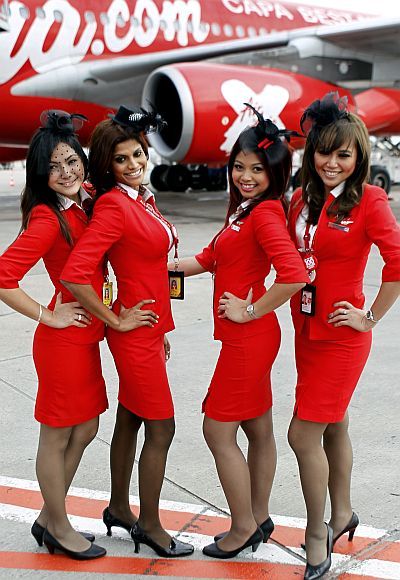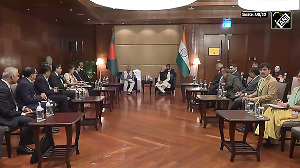The airline company's losses touched Rs 21 crore (Rs 210 million) -- going by newspaper reports -- for the October-December quarter, notes Anjuli Bhargava
 Before it started operations in India, low-cost airline AirAsia India had promised many things.
Before it started operations in India, low-cost airline AirAsia India had promised many things.
It had said it would bring in one aircraft every month.
It has been nine months since it started and it has three aircraft.
It had said it would break even in six months.
Its losses touched Rs 21 crore (Rs 210 million) -- going by newspaper reports -- for the October-December quarter.
Accumulated losses since June would be higher still.
It said it would offer fares that were 30 per cent lower than rivals but with SpiceJet's fares headed consistently southward, it's been a hard act to follow.
After launching flights in June 2014, AirAsia and its already famous CEO Mittu Chandilya (few have heard of the airline but almost everyone knows the CEO) changed their tune a bit.
In October 2014, in an interview to Business Standard, Chandilya had said the airline would have six aircraft by the end of 2014.
That didn't happen.
Flights from Delhi were meant to begin by end-2014.
They haven't as yet.
Flights from Mumbai were to start early 2015. No sign. The proposed date for break even, November 2014, came and went.
That's now changed to May-June 2015 (one year after launch).
The CEO has said that he hopes to induct 15 aircraft in 2015, reaching one-fifth of IndiGo's fleet of 100 within 18 months of starting operations.
He has time and again promised to revolutionise Indian aviation and be the number one on every route he flies.
Well, well, well.
What can one say?
I spoke to a few aviation industry people on what they think of AirAsia India's performance so far and why it has hardly managed to make any impact.
One, the airline has made several operational blunders.
With just three aircraft, the airline should have stuck to a fewer routes -- perhaps in the south -- consolidating its position on its initial routes and trying to increase frequencies on these.
Instead, it committed the classic mistake of spreading itself too thin.
Within months of launch and with just three aircraft, it started flying to Jaipur and Chandigarh and even Bengaluru-Pune-Jaipur.
Two, slots and timings have been quite haywire.
To cite one instance: one of its first flights, Bengaluru-Chennai, was at 6 a m.
Perhaps, this time slot was forced upon AirAsia because it started its operations recently, but to reach the Bengaluru airport from almost anywhere in the city at 5 a m (check-in time), you would have to wake up around 3 a m. Who in his right mind would choose to do that? The flight has now been withdrawn.
Flight cancellations have been rising. In several months, according to a senior Directorate General of Civil Aviation official, AirAsia India has been second to SpiceJet in the number of cancellations.
This has apparently happened due to a shortage of cabin crew, where the attrition rates seem to be quite high.
Why this should happen in a brand new airline, he points out, is for it to answer.
At a more macro level, some other factors have not worked in AirAsia's favour.
The alliance with the Tata group was one of the USPs for the airline. It gave the brand a certain image, sheen and pull.
But with Vistara coming in and the Tata group's attention clearly far more focused on that venture, AirAsia India has hardly been able to leverage the Tata association.
To be fair, the Tatas had taken a minority stake in AirAsia, so the level of involvement could not be anywhere as high.
AirAsia's USP globally and in its major markets where it has been successful is its sharply lower fares.
Typically, it is able to offer fares that are 30-40 per cent below its competition in most markets where it operates and is profitable.
But the period of its launch in India coincided with the downfall of SpiceJet and its frenetic discounting.
SpiceJet was offering rock-bottom fares and going any lower would mean offering seats virtually for free.
Unlike in many other markets where competition exists but is not as much of a force to reckon with, Air Asia India has its task cut out competing with IndiGo which, is undoubtedly a far stronger product.
IndiGo offers an on-time, hassle-free, reliable service with multiple frequencies with very few cancellations on almost every route where AirAsia flies.
One may try AirAsia once but for those who value reliability, IndiGo is the obvious choice unless the fare difference is gaping.
So, not only is the size of the rival intimidating, but so is what it brings to the table.
Image: Stewardesses pose in front of an Airbus A340 passenger jet. Photograph: Charles Platiau/Reuters











 © 2025
© 2025